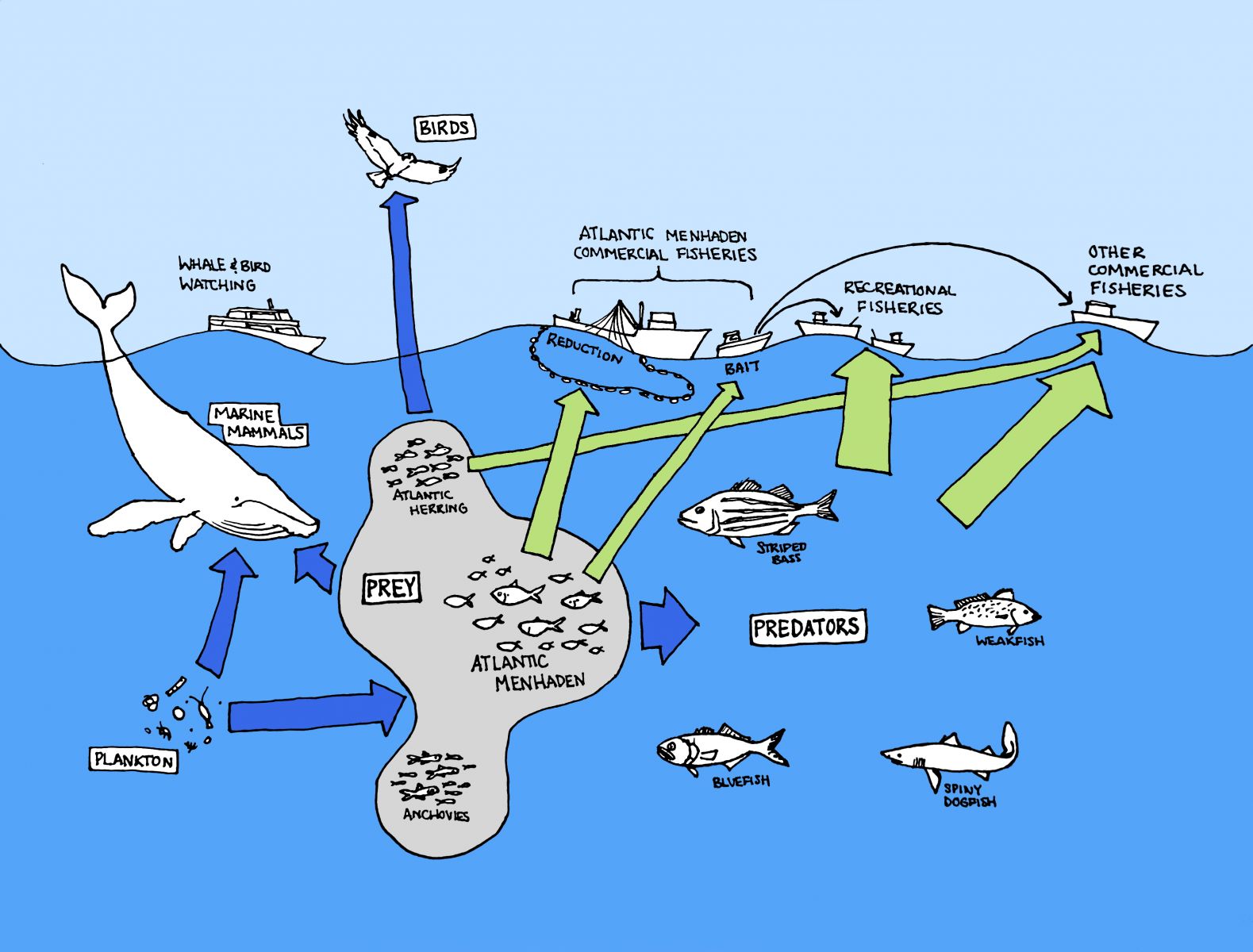Multispecies and Ecosystem Approaches
In recent years, there has been an increasing push towards ecosystem approaches to fisheries management. Traditionally, fisheries have been assessed and managed on a species-by-species basis. However, species do not exist in a single-species vacuum in their natural environments. For example, availability of food, the level of predation, and the prevailing environmental conditions, among many other factors, can all impact a fish population. At the same time, that fish population impacts the ecosystem around it, including its predator and prey species. These interactions are essential to understand because management decisions for one species could have unforeseen impacts elsewhere, including on other fisheries, endangered species, and the ecosystem as a whole. Ecosystem-based approaches to fisheries management seek to account for these ecosystem interactions when managing fisheries.
The Commission has taken the lead in implementing innovative quantitative ecosystem approaches to fishery management on the Atlantic coast with the management of horseshoe crab and Atlantic menhaden, summarized below.
Horseshoe Crabs and Shorebirds

Red knots and horseshoe crabs. Photo credit: USFWS
Horseshoe crabs are found along the Atlantic coast from northern Maine to the Yucatan Peninsula and the Gulf of Mexico. The Delaware Bay supports the largest spawning population in the world. During the high tide, horseshoe crabs come ashore to lay their eggs in sandy beach areas. Migratory shorebirds like red knots stop and rest in the Delaware Bay region during this spawning period, and horseshoe crab eggs are an important food source for them on their long migrations. Horseshoe crabs are also harvested for use as bait in commercial fisheries for eel and conch, and their blood is collected to make Limulus Amoebocyte Lysate (LAL), a chemical that aids in the detection of human pathogens in patients, drugs, and intravenous devices.
The Commission uses an Adaptive Resource Management (ARM) framework to set horseshoe crab harvest levels for the Delaware Bay region. The ARM framework uses information on both horseshoe crab abundance and red knot abundance to set harvest levels for the fishery while also ensuring the horseshoe crab population in the Bay can produce enough eggs to support the red knot population as it migrates through.
Contact
Kristen Anstead, Stock Assessment Scientist
Documents
2019 Horseshoe Crab Benchmark Stock Assessment and Peer Review Report (May 2019)
Horseshoe Crab Stock Assessment Overview (May 2019)
2013 Horseshoe Crab Stock Assessment Update (August 2013)
ASMFC Stock Assessment Overview for Horseshoe Crab (February 2010)
Terms of Reference & Advisory Report to the Horseshoe Crab Stock Assessment Peer Review (November 2009)
Horseshoe Crab Stock Assessment for Peer Review (November 2009)
A Framework for Adaptive Management of Horseshoe Crab Harvest in the Delaware Bay Constrained by Red Knot Conservation (November 2009)
Terms of Reference Report for the Stock Assessment of Atlantic Coast Horsehoe Crabs: A Proposed Framework (January 2006)
Atlantic Menhaden

Atlantic menhaden serve a critical role in converting primary production from small invertebrates (like plankton) into fish protein. In turn, Atlantic menhaden, along with other forage fish, such as Atlantic herring and anchovies, are an important food source for a number of animals including whales, birds, and various predatory fish, such as Atlantic striped bass, weakfish, bluefish and spiny dogfish. Additionally, menhaden directly support bait and reduction fisheries and indirectly support, through its role as prey, ecosystem activities, like bird and whale watching and recreational fishing. Image credit: Sarah Murray, ASMFC
Atlantic menhaden have supported one of the largest fisheries in the U.S. since colonial times, with landings going into fish meal, fish oil, and bait for other fisheries. However, Atlantic menhaden are also a food source for wide range of species including Atlantic striped bass, bluefish, sea birds, and marine mammals. Many of these predators support valuable commercial and recreational fisheries or ecotourism industries.
Efforts to take into account menhaden’s role as a forage fish began in the early 2000s with the development of the multispecies Expanded Virtual Population Analysis (MSVPA-X) model. More recently, the Commission’s Ecological Reference Points (ERP) Work Group was tasked with developing reference points that could account for Atlantic menhaden’s role as a forage fish. The work group explored a suite of models to develop ERPs, ranging from very simple to very complex. The ERP Work Group ultimately recommended using the Northwest Atlantic Coastal Shelf Model of Intermediate Complexity for Ecosystems (NWACS-MICE) in combination with the single-species model to evaluate tradeoffs and set ERPs for Atlantic menhaden. NWACS-MICE is a streamlined ecosystem model for Atlantic menhaden that includes Atlantic herring, bay anchovy, striped bass, weakfish, spiny dogfish, and bluefish. Using this model in combination with the single-species model, the Atlantic Menhaden Technical Committee, Stock Assessment Subcommittee, and ERP Work Group developed ecosystem-based reference points for menhaden that account for its role as a forage fish. ERPs were adopted for use in the management of Atlantic menhaden in August 2020 and were used by the Atlantic Menhaden Board to set menahden total allowable catch for the 2021 and 2022 fishing seasons in October 2020.
For more information about our efforts to develop and implement ERPs for Atlantic menhaden, check out our story map. Scroll through photos and figures to better understand what ERPs are, how they are used in the management of menhaden, and how they work towards achieving ecosystem approaches to fisheries management.
Contact
Jainita Patel, Fisheries Science Coordinator
Documents
ERP
Atlantic Menhaden Assessments Overview (February 2020)
Atlantic Menhaden Ecological Reference Point Benchmark Assessment and Peer Review Report (January 2020)
SEDAR Stock Assessment Report for Atlantic Menhaden (January 2015)
MSVPA Documents
MSVPA-X Model Background Information: Data Sources and Model Documentation
2006 MSVPA-X Peer Review - SARC 42
Other Resources
NEFSC Ecosystem Considerations Website